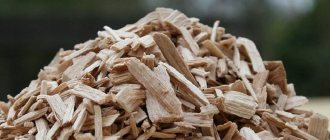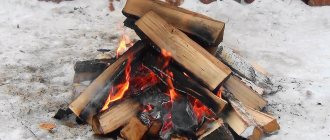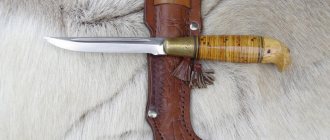Book | Video | About the project | Contacts | Sitemap | Forum | Blog | Construction | Eng
Home > Taiga articles > Taiga forests. Taiga plants
Boreal taiga forests are the largest ecosystem in northern Eurasia, North America and Scandinavia. Taiga plants are represented mainly by conifers, mosses, lichens and small shrubs, but taiga is different. There are several types of boreal taiga forest, in which certain plants predominate. Taiga forests are divided into light-coniferous taiga, dominated by pine and larch, and dark-coniferous taiga, dominated by spruce, Siberian cedar, and fir. The taiga soil is soddy-podzolic and acidic.
Let's look at the main plants of the taiga, which in some way can be useful to a traveler, hermit or commercial hunter.
First, let's look at the habitat of these plants:
We see that coniferous forests spread across almost the entire north of the land. On my own behalf, I would like to add that taiga also covers the mountain ranges of the European Alps, the Carpathians, and the Rocky Mountains of North America, which is not shown in the diagram.
Coniferous trees of taiga forests
Siberian spruce
The most important representative of the taiga. The basis of the dark coniferous taiga, which has become its symbol. Most often, spruce grows in mixed forests, but is often the main forest former. Spruce wood is used in logging and is suitable for construction, although a little worse than pine wood. A spruce cone appears at the age of 15 to 50 years, depending on the place of growth. The interval between harvests is 3-5 years. Needles and cones are rich in vitamin C and other beneficial substances, and they also contain a lot of essential oils. The needles secrete phytoncides that play an antibacterial role.
Scots pine
Pine forest
Scots pine, along with spruce, is widespread in Russia. The basis of the light-coniferous taiga. Pine wood is widely used in construction; due to its high resin content, it is one of the best natural building materials in the taiga zone. The resin has a very pleasant smell and is used for distilling tar, turpentine, and rosin. Previously, resins were widely used in shipbuilding and other construction projects that required the preservative properties of pine. The needles contain vitamin C and other beneficial substances.
Fir
I call fir the most affectionate tree of the dark coniferous taiga due to the fact that its needles are very soft and do not prick at all. Fir paws are good to use for bedding if you spend the night in the forest without a tent or foam mat. I also prefer to drink tea with brewed needles. The tea turns out aromatic, although without vitamins, since vitamins are destroyed when heated. Fir wood is little used and is poorly suited for construction.
Fir is more of a medicinal tree than a building material. Fir resin can be used to cover wounds: it has an antiseptic effect and promotes their rapid healing. Fir oil is widely used in cosmetics.
Siberian cedar
I already have an article about Siberian cedar. Let me just say that this is the most noble tree of the dark coniferous taiga. Pine nuts are highly valued due to their rich composition of nutrients. The presence of pine trees in the taiga indicates the presence of fur in it, which is another important factor. Cedar wood is used in construction and carpentry. It has a reddish tint and a pleasant smell. The wood is less resinous than pine wood. Cedar lives up to 800 years. The growing season is 40-45 days a year. The cones ripen within 14-15 months. Each cone contains from 30 to 150 nuts. Cedar begins to bear fruit on average after 60 years, sometimes later.
Larch
Larch forest, Yakutia
Larch is the hardiest tree in the taiga zone. It grows in mixed forests, but most often, due to its resistance to frost, larch forms a monoforest - larch. Larch can withstand frosts of -70°C, and even more. The needles are annual, not at all prickly, soft. Larch loves light areas of the area, so it is very difficult to find it in dark coniferous forests. As a rule, these will be solitary trees or monoleaf forests. Larch wood is very dense due to the short growing season. She has many rings. A thin tree can be very old. Very well suited for construction, it is a desirable material for making the first crowns of taiga winter huts. Wood is not afraid of moisture and rots very slowly. Contains a lot of resin.
Taiga plants
Taiga is a real kingdom of coniferous trees, in which small-leaved species (aspen, birch, rowan, alder) are found only occasionally.
Since there are a lot of swamps in these parts, the surface of the soil is almost completely covered with a carpet of moss and lichens. On the banks of taiga rivers there are dense thickets of wild raspberries, lingonberries, blueberries, and cloudberries. These berries are able to ripen quickly in a short summer and produce a rich harvest by early autumn.
Rice. 2. Blueberries.
Coniferous trees differ from each other, and they are usually divided into two types :
TOP 4 articles that are read along with this
- Light conifers (pine, larch). These trees prefer good lighting and space and are very frost-resistant.
- Dark conifers (cedar, fir, spruce). They are not demanding of light, but they tolerate severe frosts and heat much worse.
Rice. 3. Cedar.
The hardiest tree in the taiga is considered to be larch, which can withstand temperatures down to -70C. Unlike other coniferous trees, they shed their soft needles every fall in order to grow new young needles the following spring. Larch wood is highly valued due to its high density and resistance to rot and moisture.
Deciduous taiga trees and shrubs
Birch
The most popular representative of deciduous trees in the taiga forest. Distributed everywhere. Present in almost all mixed forests of northern latitude. Almost all parts of this tree are widely used. Wood is used for construction, crafts, and carpentry. Tar is extracted from the bark, various items are made, and it burns well. In the spring, birch sap, rich in vitamins and sugars, is extracted from living birch trees. Buds and leaves are used in medicine.
Aspen
Another representative of deciduous species in the taiga. Aspen is a relative of poplar; their bark can even be confused. Used for landscaping settlements as a fast-growing tree. The bark is used for tanning leather. It is used to produce yellow and green paint. Bees collect pollen from aspen flowers in April, and glue from the blossoming buds, which is processed into propolis. It is used in the construction of houses, used as roofing material (in Russian wooden architecture, church domes were covered with aspen planks), in the production of plywood, cellulose, matches, containers and other things. Young growth is winter food for moose, deer, hares and other mammals. It is a medicinal plant. Aspen has antimicrobial, anti-inflammatory, antitussive, choleretic and anthelmintic effects. The combination of antimicrobial and anti-inflammatory properties in aspen bark makes it promising in the complex treatment of tuberculosis, smallpox, malaria, syphilis, dysentery, pneumonia, coughs of various origins, rheumatism and inflammation of the bladder mucosa. An aqueous extract of aspen bark is used to treat opisthorchiasis.
Green alder
From the Berezov family. In the north it is a small shrub, in the south it is a tree about 6 m in height. Distributed in the taiga zone, less common than birch and aspen. Grows on wet soils. Bark and leaves provide dye for animal skins. Practically not used in everyday life. It is food for moose and serves as a refuge for game animals.
Linden
In the taiga forest, this guest is quite rare; it grows mainly in the south, in the central part of Russia, here and there in Western Siberia and in the Amur taiga. Wood is widely used in carpentry and joinery; it lends itself well to processing due to its softness. Medicines are made from some parts of the linden tree, and it is also an excellent honey plant. Basts, bast shoes, and mats are made from the bark of the tree (bast).
Rowan
Widely distributed throughout Europe, Asia and North America. It grows everywhere in the taiga. The use of rowan is small. The berries are eaten, rowan is a honey plant, and carpentry is made from the wood. The berries are used in folk medicine as an antiscorbutic, hemostatic, diaphoretic, diuretic, choleretic, laxative and as a remedy for headaches. Fresh rowan fruits have a bitter taste, but the first frosts lead to the destruction of the bitter glycoside sorbic acid - and the bitterness disappears. The fruits of the most famous variety of rowan (nevezhinskaya), containing up to 9% sugar, have a sweet taste even before frost.
Juniper
A small shrub that grows everywhere in the taiga. It also grows in the mountains of Nepal, Bhutan, and Pakistan. The fruits are cones and contain sugars, organic acids and microelements. Juniper is widely used in folk medicine due to its high content of phytoncides. Used in the treatment of various diseases such as tuberculosis, kidney disease, bronchitis, etc.
Cedar elfin wood
It grows in relatively mountainous areas, on the border of taiga and tundra. It grows on stones, very slowly, and lives up to 250 years. The resin of dwarf cedar is rich in various substances. Turpentine is obtained from resin, which is an antiseptic, diuretic, causing skin hyperemia, and anthelmintic. Used to treat kidneys and bladder. Nuts are rich in nutrients and are in no way inferior to their older brother - Siberian cedar. Previously, pine needles were used as an antiscorbutic remedy; it also contains more carotene than carrots.
Author: Oleg Prikhodko
Read more
general characteristics
Taiga occupies a very vast territory and makes up about 30% of all forests on the planet. In Russia, it is located over impressive areas of Siberia and the Far East.
This natural area is characterized by harsh climatic conditions and soil composition. The features of the taiga include:
- Long, cold winters and short, relatively warm summers. In Eastern Siberia in winter, the thermometer often drops to -50C.
- Precipitation in summer is not too abundant, ranging from 200-750 mm per year.
- High humidity in the region, combined with permafrost, prevents the evaporation of moisture, which stagnates in the upper layers of the soil. This leads to swamping of the area and the formation of numerous swamps and lakes.
- In the taiga, podzolic soils predominate - very poor, with low humus content. Humus is the most important component of soil containing nutrients.
Rice. 1. The harsh climate of the taiga.
Only a few plants can withstand such conditions. That is why coniferous trees predominate in the taiga zone, as they are the most unpretentious and adapted to the harsh climate.
The taiga is often called the “green lungs of the planet.” And this is not without reason - vast areas of taiga forests maintain a delicate balance of carbon dioxide and oxygen in the atmosphere.
Taiga fauna
The taiga forests are home to large and small mammals, birds and insects that have been able to adapt to life in such harsh conditions. Animals here include both carnivores and herbivores. The most common birds are the white owl, the bald eagle, the great eagle owl, and the red-tailed buzzard. Arachnids are represented by scorpions, insects by mosquitoes. The taiga is home to a large number of species, the most common are listed below.
Brown bear
Brown bear
Found in the taiga forests of Eurasia and North America. The weight of an adult animal reaches 268 kg for males and 175 kg for females. The fur color is usually brown, but there are individuals with light fawn or almost black fur. In winter, bears hibernate for 75–195 days.
Interesting: Black Sea











